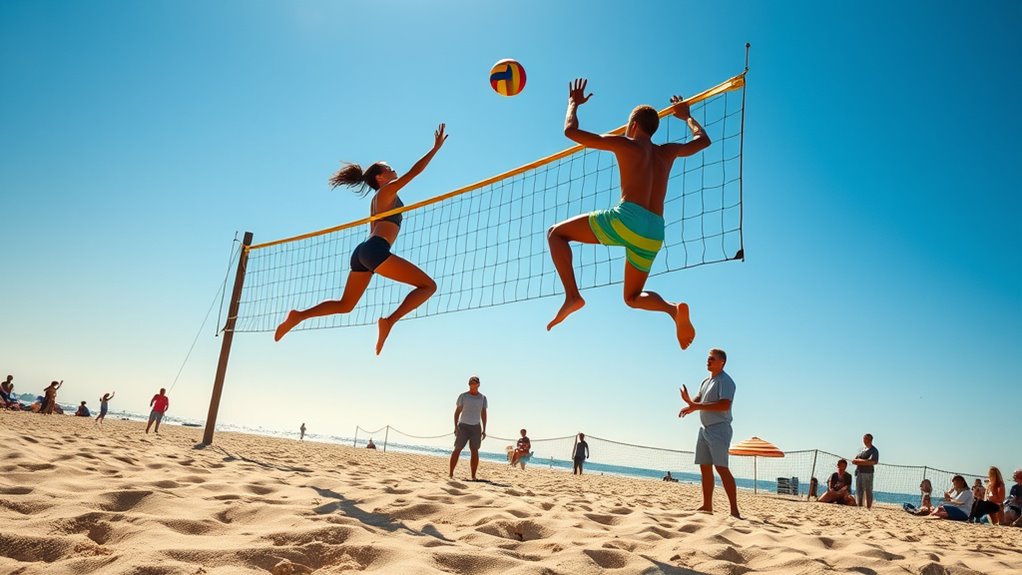To get started with beach volleyball, focus on understanding the basic rules, scoring system, and court layout. Use proper equipment like sand-friendly shoes, a good outdoor volleyball, and sun protection gear. Learn key techniques such as passing, setting, and serving, and know your role on the court. Strategy and awareness help you play smarter and avoid common faults. Keep exploring, and you’ll soon master the essentials to enjoy and improve your game.
Key Takeaways
- Understand the rules, scoring system, and common violations to play fair and strategically.
- Familiarize yourself with equipment, court dimensions, and proper gear for safety and performance.
- Learn player roles, positions, and techniques like passing, serving, and attacking for effective teamwork.
- Develop strategies using varied serves, attacks, and communication to outplay opponents.
- Prepare with outdoor gear, sun protection, and mental focus for a safe, enjoyable beach volleyball experience.
Understanding the Rules and Scoring System
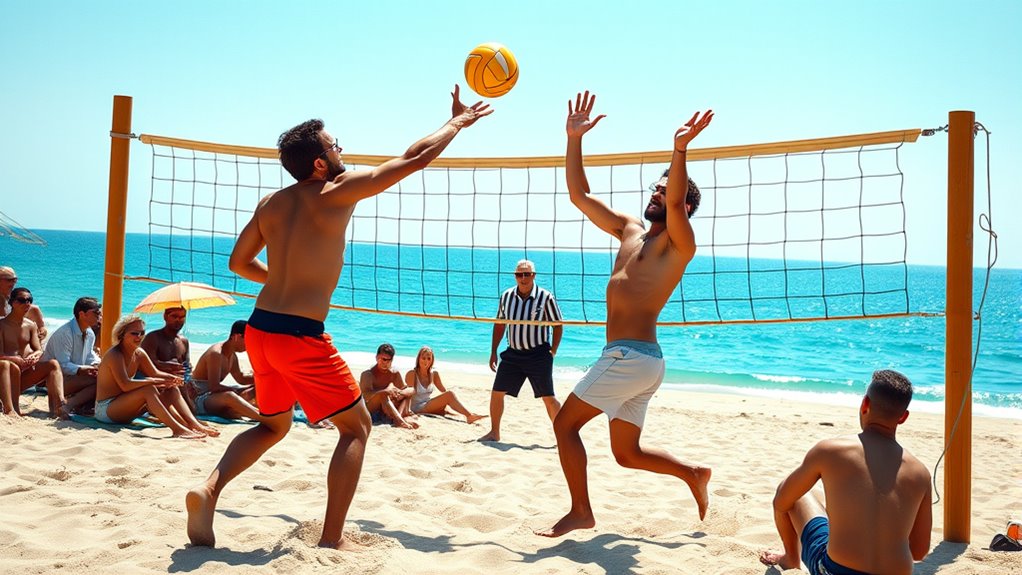
To play beach volleyball effectively, you need to understand the rules and scoring system that govern the game. The game is played with two teams of two players each, and the goal is to land the ball on the opponent’s side without them returning it. A match typically consists of best-of-three sets, with each set played to 21 points. You score a point when the opposing team commits a fault or fails to return the ball properly. You only earn points when your team is serving, except in some tournaments where rally scoring applies. The team that reaches the set point first wins the set. Winning two sets wins the match. Knowing these rules helps you stay focused and play confidently. Proper gear and equipment like a good volleyball and appropriate footwear can also significantly impact your performance. Additionally, understanding the court dimensions and layout ensures proper positioning and movement during play. Familiarity with the scoring system helps players strategize and maintain momentum throughout the match. Moreover, being aware of the rules for faults and violations allows players to avoid penalties and play within the boundaries of fair competition. An understanding of player positions and rotations can also improve team coordination and effectiveness during the game.
Essential Equipment and Gear
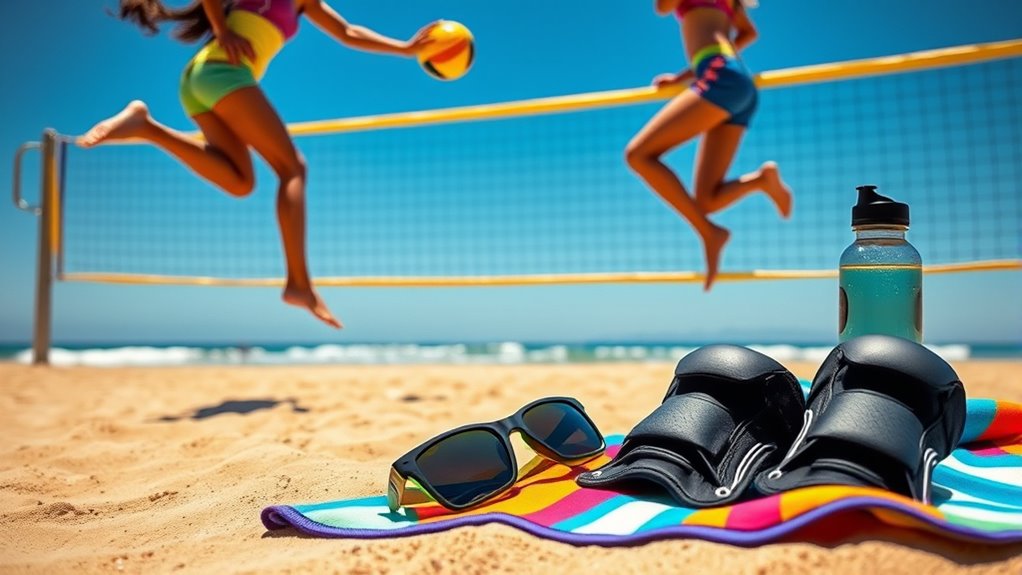
Getting the right equipment is vital for playing beach volleyball effectively and comfortably. First, invest in a good pair of volleyball shoes designed for sand; they provide traction and protect your feet. A quality volleyball made specifically for beach play is indispensable; it’s usually softer and designed to handle outdoor conditions. Wear comfortable, breathable clothing suitable for warm weather—tank tops, shorts, or swimsuits work well. Don’t forget sunglasses and a hat to shield your eyes from the sun. A towel and sunscreen are also necessary to stay comfortable and protected during play. If you’re playing regularly, consider a portable net system for setup on different beaches. Proper gear ensures you stay safe, focused, and ready to enjoy the game. Using appropriate equipment can also help prevent injuries and improve your overall performance. Additionally, selecting gear that suits outdoor conditions can enhance your comfort and durability during matches. Being aware of lifestyle and money considerations, like investing in quality gear that lasts, can make your beach volleyball experience more enjoyable and cost-effective over time. Incorporating beach-specific gear with features designed for sand and sun can further optimize your playing experience.
Basic Techniques: Passing, Setting, and Serving

To improve your game, focus on mastering passing precision techniques to control the ball accurately. Developing effective serving strategies can put your opponents on the defensive from the start. By honing these skills, you’ll become a more confident and consistent player on the beach.
Passing Precision Techniques
Mastering passing precision is essential for maintaining control and setting up effective plays in beach volleyball. To improve your passing accuracy, focus on positioning yourself correctly under the ball. Keep your eyes on the ball and move quickly to meet it, using your arms to create a platform. Keep your hands steady and firm, with wrists relaxed but firm enough to guide the ball accurately. Aim to contact the ball at a consistent point, ideally just above your forehead, to direct it smoothly to your setter. Maintain a low, balanced stance to stay agile and ready for follow-up plays. Practicing these techniques regularly will help you deliver precise passes, giving your team a strong foundation for successful attacks. Understanding city dynamics can also help players anticipate opponents’ moves and adapt your passing strategies accordingly, especially when navigating different playing environments. Developing your communication skills with teammates can further improve overall passing effectiveness and team coordination. Additionally, focusing on paint sprayer techniques can enhance your ability to prepare surfaces effectively before play, ensuring a smooth environment for your team’s performance.
Effective Serving Strategies
Effective serving strategies are essential for gaining an early advantage in beach volleyball, as a well-placed serve can disrupt your opponents’ rhythm and set the tone for the rally. Focus on consistency and placement to keep opponents on their toes. Aim for deep serves to push them back, or target their weaker passers to create openings. Mix up your serves to prevent predictability, combining float serves with topspin for variety. Use your body to generate power and control, and aim for the corners or sidelines. Remember, a strong serve can force errors or poor passes, giving your team an immediate edge. Additionally, understanding relationship dynamics can improve team coordination and communication during plays. Developing a good understanding of team communication can significantly enhance your serving effectiveness and overall gameplay. Incorporating elements like serve placement and adjusting your speed can further increase your success rate, especially when considering how opponent tendencies influence their receiving ability.
Player Positions and Roles

In beach volleyball, each player has specific responsibilities that keep the team functioning smoothly. You’ll see setters orchestrating the offense, defenders covering the court, and attackers executing powerful hits. Understanding these roles helps you anticipate plays and improve your overall game. Recognizing player positions and roles is essential for developing effective strategies and teamwork.
Setter Responsibilities Overview
The setter plays a vital role on the beach volleyball court by orchestrating the offense and setting up scoring opportunities. Your main responsibility is to deliver accurate, quick sets to your attackers, giving them the best chance to score. You need to read the opposing blockers and adjust your sets accordingly, often changing the ball’s height and placement. As the playmaker, you must stay alert and communicate effectively with your partner, ensuring smooth progressions between offense and defense. Quick decision-making is essential—you often have only seconds to choose the best set. Your positioning and timing directly influence your team’s offensive success. Staying consistent and confident with your sets helps keep the opposing team off balance and creates more scoring chances for your side. Paying attention to mental clarity and focus can enhance your reaction time and decision-making skills during plays. Developing strong court awareness allows you to anticipate opponents’ moves and adapt your sets accordingly, increasing your effectiveness. Incorporating proper hydration and nutrition can also improve your physical endurance and mental sharpness during matches. Additionally, understanding player roles and responsibilities can help you better coordinate with your teammates for optimal team performance. To further improve your setting skills, practicing vertical storage solutions can help organize your gear and keep your focus on the game.
Defensive Player Duties
As a defensive player on the beach volleyball court, your primary role is to anticipate and respond to the opponent’s attacks. You need to stay alert, reading the hitter’s body language and shot patterns to predict where the ball will go. Position yourself quickly to cover your designated area, whether it’s deep, mid, or close to the net. Your main responsibilities include digging hard-hit spikes, covering tips and roll shots, and maintaining a low, balanced stance for quick reactions. Effective communication with your partner is vital—calling for the ball and switching coverage as needed. Stay disciplined, stay focused, and keep your movements controlled to guarantee you’re always ready to make a successful save.
Attackers’ Offensive Roles
Ever wonder how attackers coordinate their roles to break through the defense? As an attacker, your main goal is to execute powerful and well-placed hits to score points. You’ll often take turns attacking from different positions, like the outside hitter, opposite, or right-side hitter. Your role involves reading the setter’s set and deciding whether to spike, tip, or roll shot. Timing is vital—you need to jump at the right moment to maximize power and accuracy. Communication with your teammates helps you avoid collisions and set up effective plays. After the attack, you may need to switch swiftly into a defensive position. Your versatility and quick decision-making are key to overwhelming opponents and maintaining offensive pressure throughout the game.
Court Dimensions and Layout
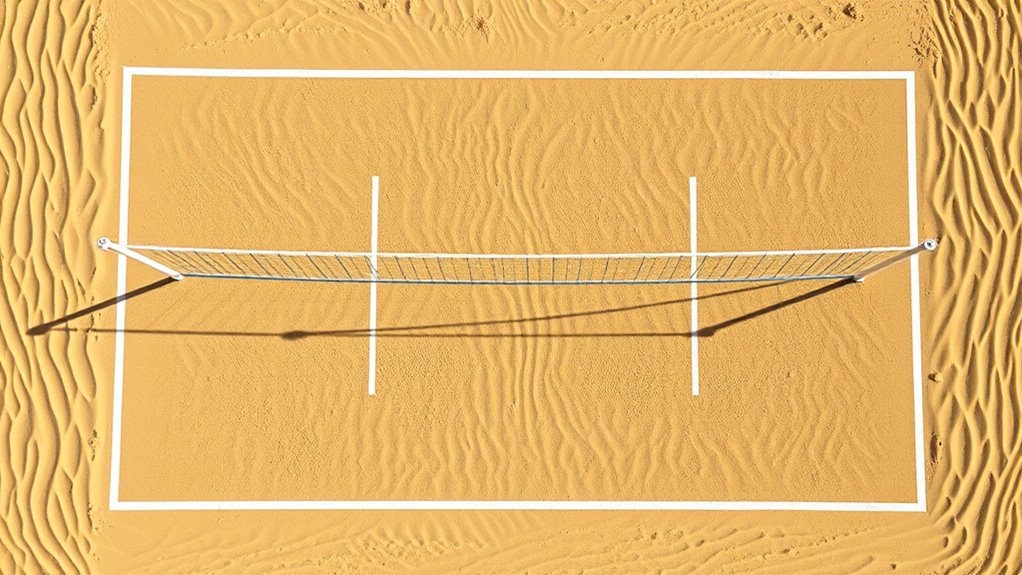
A standard beach volleyball court measures 16 meters long and 8 meters wide, providing enough space for players to move and perform. The court is divided into two equal halves by a net that stands 2.43 meters high for men and 2.24 meters for women. Each side has a boundary line, sidelines, and a centerline beneath the net. The attack line, located 3 meters from the net, marks the front and back zones. The layout ensures players have room to execute serves, passes, and spikes while maintaining clear boundaries. Proper understanding of the court’s dimensions helps you position yourself correctly and play within the rules. The layout also promotes fair play and strategic movement during each rally.
Strategies for Effective Play
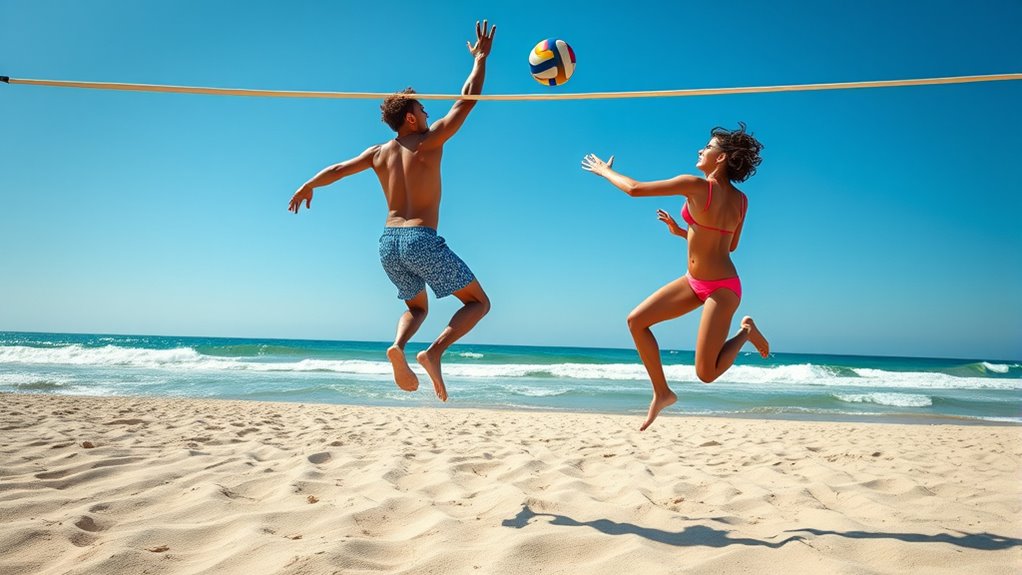
To play beach volleyball effectively, you need to combine solid communication, strategic positioning, and quick decision-making. Clear, constant talk with your partner helps you anticipate plays and cover the court efficiently. Focus on positioning yourself based on the ball’s location and your opponent’s setup. Stay alert to shifts in play so you can adjust your stance or move quickly to intercept or block shots. Use strategic serves to target weaker opponents or force errors. Mix up your attacks with sharp spikes, soft tips, or deep shots to keep your opponents guessing. Always stay aware of your partner’s position and intentions, supporting each play with coordinated movement. By applying these tactics, you’ll improve your chances of winning points and controlling the game.
Common Violations and Penalties

Understanding common violations and penalties is key to maintaining a fair and smooth game. When you know the rules, you can avoid costly mistakes that give your opponents an advantage. Here are four common violations to watch out for:
- Foot Fault – Stepping on or over the boundary line during a serve or attack.
- Net Violation – Touching the net while playing, which results in a point for the opponents.
- Lift or Carry – Using an illegal overhead catch or scoop, causing a fault.
- Double Hit – Striking the ball twice in succession by the same player, unless during a block.
Staying aware of these violations helps you play confidently and keeps the game fair for everyone involved.
Tips for Improving Your Skills

Improving your beach volleyball skills requires consistent practice and targeted effort. Focus on developing your fundamentals, like passing, setting, and spiking, by dedicating time to drills that simulate game situations. Work on your footwork to stay agile and position yourself better for each play. Watching experienced players can help you learn new techniques and strategies; try to analyze their movements and decision-making. Practice your serves regularly to increase accuracy and power. Additionally, improve your communication with teammates, which is essential for coordination and quick responses. Stay patient and track your progress over time. Small, consistent improvements will build confidence and skill, helping you perform better during matches and enjoy the game even more.
Frequently Asked Questions
How Do Weather Conditions Affect Beach Volleyball Gameplay?
Weather conditions play a big role in your beach volleyball game. Wind can blow the ball off course, making passes and serves tricky. Sun glare might blind you or your teammates, affecting communication and focus. Hot temperatures can tire you out faster, while rain or moisture makes the sand slippery, increasing the risk of falls. Adapting to these conditions helps you stay sharp and perform well, no matter the weather.
What Are Common Injuries and How Can They Be Prevented?
You might think injuries are just part of the game, but they’re actually avoidable. Common issues include sprains, strains, and sunburns. To prevent them, warm up properly, wear sunscreen, and stay hydrated. Use ankle braces if you’re prone to twists. It’s ironic how many players ignore simple precautions and end up sidelined. So, protect yourself, and keep the game fun and safe—because injuries shouldn’t be your highlight reel.
How Can Beginners Improve Their Agility on Sand Courts?
To improve your agility on sand courts, focus on strengthening your leg muscles through plyometric exercises and cardio workouts. Practice quick lateral movements and jumping drills to boost your speed and responsiveness. Keep your knees slightly bent and stay low during play, which helps with balance and quick directional changes. Consistent practice and proper warm-ups will enhance your agility, making you more agile and confident on the sand.
What Are Some Effective Communication Strategies Between Teammates?
Did you know teams that communicate effectively win 30% more points? When you and your teammate talk openly, use clear signals, and stay positive, you create a strong connection on the court. Always call for the ball confidently, listen actively, and give quick feedback. These strategies keep you both on the same page, boost your coordination, and make your gameplay more successful and enjoyable. Good communication truly makes a difference!
How Does Beach Volleyball Differ From Indoor Volleyball Rules?
In beach volleyball, you play with two players per team, unlike indoor volleyball’s six. The court is smaller, and you can touch the ball only three times before sending it over, with no lifts or carries allowed. Serves are often harder due to the wind, and players switch sides after every 7 points. These rule differences keep the game fast-paced and require you to be more versatile and strategic.
Conclusion
As you step onto the sandy court, imagine yourself seamlessly passing, setting, and serving, each movement flowing like waves crashing on the shore. With the right equipment, solid techniques, and understanding of roles, you’ll find yourself more confident with every game. Just like the sun setting perfectly over the horizon, your skills will align, and you’ll enjoy the thrill of beach volleyball. Keep practicing, and soon, you’ll create your own beautiful shoreline of success.

